
Industrial Control Classroom【www.gkket.com】Essential website for engineers
Add WeChat:gk-auto Join WeChat group
Electrical Automation – Free Materials Worth Over Ten Thousand
Click to Download for Free
(DownLoad)
Serial communication is the most basic communication method faced by electrical engineers, and RS-232 is the simplest among them. Many beginners often confuse UART with RS-232, RS-422, and RS-485, so this article will discuss the understanding of these concepts to help clarify their relationships.
If we compare serial communication to traffic, UART is like a station, while a frame of data is akin to a car. Cars must follow traffic rules on the road. If it’s in the city, the speed limit is generally 30 or 40, while on the highway it can go up to 120. What road the car takes and the speed limit depend on the protocol specifications. Common serial protocols include RS-232, RS-422, and RS-485. What are the subtle differences between them? Let’s explore.
1. What is UART
UART stands for Universal Asynchronous Receiver/Transmitter, commonly referred to as UART, which is a key module for asynchronous communication between devices. UART is responsible for handling the serial/parallel conversion between the data bus and the serial port, as well as specifying the frame format; as long as both communicating parties adopt the same frame format and baud rate, they can complete the communication process using only two signal lines (Rx and Tx) without sharing a clock signal, thus it is also known as asynchronous serial communication.
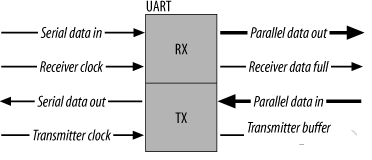
If a suitable level converter, such as SP3232E or SP3485, is added, UART can also be used for RS-232 and RS-485 communication or connect to a computer port. UART is widely used in applications such as mobile phones, industrial control, and PCs.
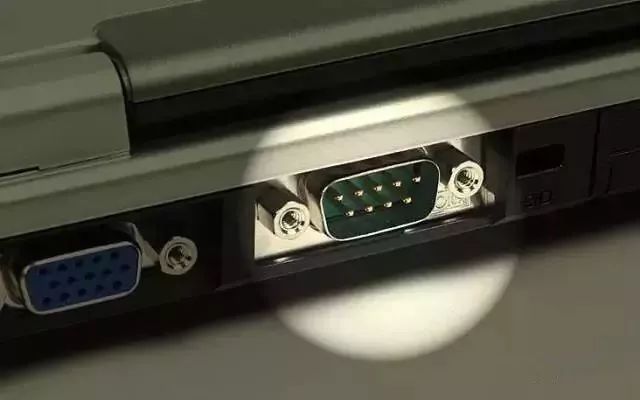
UART uses asynchronous serial communication.
Serial communication refers to the process of transmitting data bit by bit over a single transmission line. Its characteristics include a simple communication line, which can be achieved using simple cabling, reducing costs, and it is suitable for long-distance communication but has a slower transmission speed.
Asynchronous communication uses a character as the unit of transmission, and the time interval between two characters is not fixed; however, the time interval between two adjacent bits within the same character is fixed.
The data transmission rate is expressed in baud rate, which indicates the number of binary bits transmitted per second. For example, if the data transmission rate is 120 characters per second, and each character consists of 10 bits (1 start bit, 7 data bits, 1 parity bit, and 1 stop bit), then the baud rate is 10 × 120 = 1200 characters per second = 1200 baud.
The data communication format is shown in the figure below:
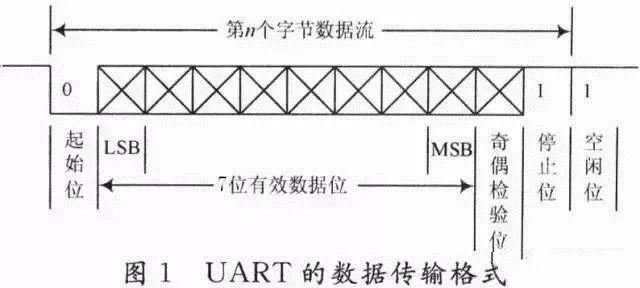
The meanings of each bit are as follows:
Start bit: A logical “0” signal is sent first to indicate the start of the character transmission. Data bits: Can be 5 to 8 bits of logical “0” or “1”. For instance, ASCII code (7 bits), extended BCD code (8 bits). Parity bit: This bit, when added to the data bits, ensures that the number of “1” bits is even (even parity) or odd (odd parity). Stop bit: It serves as an end marker for the character data. It can be 1 bit, 1.5 bits, or 2 bits of high level. Idle bit: It remains in a logical “1” state, indicating that there is no data transmission on the current line.
Note: Asynchronous communication is character-based, and the receiving device can correctly receive data as long as it can maintain synchronization with the sending device within the transmission time of a character after receiving the start signal. The arrival of the next character’s start bit recalibrates the synchronization (achieved by detecting the start bit to implement self-synchronization between the sender and receiver).

2. RS-232 Standard
RS-232 is a serial physical interface standard established by the Electronic Industry Association (EIA) in the United States. RS stands for “Recommended Standard,” and 232 is the identification number. RS-232 specifies the electrical and physical characteristics that apply only to the data transmission path; it does not include the method of data processing. It should be noted that many people often mistakenly refer to RS-232, RS-422, and RS-485 as communication protocols, which is incorrect; they are merely mechanical and electrical interface standards for UART communication (at most, they pertain to the physical layer of network protocols).
This standard specifies the use of a 25-pin DB-25 connector, detailing the signal content for each pin and specifying the voltage levels for various signals. Later, IBM simplified RS-232 to a DB-9 connector for its PC, which became the de facto standard today. The RS-232 port in industrial control typically only uses three lines: RXD (2), TXD (3), and GND (5).
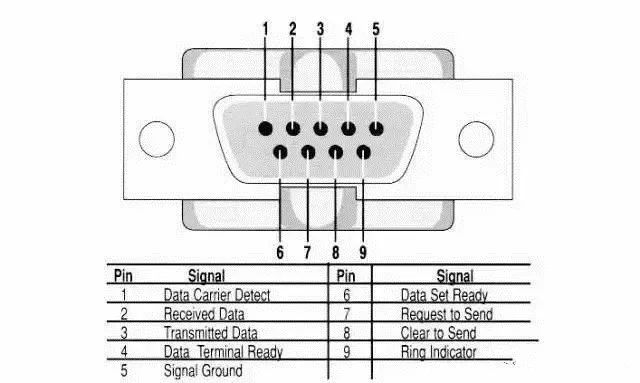
In the early days, since PCs came with RS-232 interfaces, we chose RS-232 whenever we needed to use UART. However, modern personal computers, including laptops and desktops, no longer have RS-232 interfaces; you will not find DB9 connectors on computer motherboards. Therefore, development boards now typically choose TTL UART or directly integrate UART to USB on the development boards.
In embedded systems, the serial port usually refers to the UART port, but we often confuse it with the COM port, as well as the relationships between RS232, TTL, etc. In fact, UART and COM refer to the physical interface form (hardware), while TTL and RS-232 refer to the voltage standards (electrical signals).
UART has 4 pins (VCC, GND, RX, TX), using TTL levels, where low level is 0 (0V) and high level is 1 (3.3V or above).
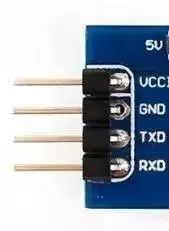
3. RS-485/RS-422 Standards
The RS-232 interface can implement point-to-point communication, but this method cannot achieve networking functionality. To address this issue, a new standard, RS-485, was developed. RS-485 uses differential transmission for data signals, also known as balanced transmission, utilizing a pair of twisted wires, with one line defined as A and the other as B.
Under typical conditions, the positive voltage between the sending driver A and B is +2 to +6V, representing one logical state, while the negative voltage is -2 to 6V, representing another logical state. There is also a signal ground C, and RS-485 has an “enable” terminal, which can be optional in RS-422.
The electrical performance of RS-422 is identical to RS-485. The main difference lies in that RS-422 has 4 signal lines: two for sending and two for receiving. Since RS-422 separates the receiving and transmitting, it can send and receive simultaneously (full duplex). Because full duplex requires separate channels for sending and receiving, RS-422 is suitable for communication between two stations, star networks, and ring networks, but not for bus networks; RS-485 only has 2 signal lines, so it can only operate in half-duplex mode, commonly used in bus networks.
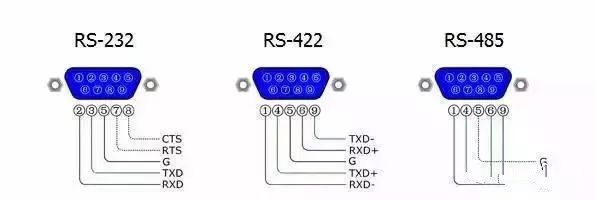
1. The electrical characteristics of RS-485: Logic “1” is represented by the voltage difference between the two wires being + (2~6)V; Logic “0” is represented by the voltage difference being – (2~6)V. The interface signal levels are lower than those of RS-232-C, making it less likely to damage the interface circuit chips, and this level is compatible with TTL levels, facilitating connections with TTL circuits.
2. The maximum data transmission rate for RS-485 is 10Mbps.
3. RS-485 interfaces use a combination of balanced drivers and differential receivers, enhancing common-mode interference resistance, thus providing good noise immunity.
4. The maximum communication distance for RS-485 is approximately 1219 meters, with a maximum transmission rate of 10Mb/s. The transmission rate is inversely proportional to the transmission distance; at a transmission rate of 100Kb/s, the maximum communication distance can be achieved. If longer distances are required, RS-485 repeaters need to be added. The RS-485 bus generally supports a maximum of 32 nodes; if special RS-485 chips are used, it can reach 128 or 256 nodes, with a maximum of 400 nodes.
Due to the earlier emergence of the RS-232 interface standard, it inevitably has some shortcomings, which include:
(1) The signal voltage levels of the interface are relatively high, which can damage the interface circuit chips; also, RS-232 levels are not compatible with TTL levels, so level conversion circuits are needed to connect with TTL circuits;
(2) The transmission rate is relatively low; during asynchronous transmission, the baud rate is 20Kbps. Now, due to the use of new UART chips, the baud rate can reach 115.2Kbps (1.832M/16);
(3) The interface uses one signal line and one return signal line to form a common ground transmission method, which is prone to common-mode interference, thus having weak noise immunity;
(4) The transmission distance is limited; the maximum standard transmission distance is 50 meters, but in reality, it can only be used at about 15 meters;
(5) RS-232 only allows point-to-point communication and does not consider forming a serial bus. (This is important; in many control scenarios, it’s one master controlling multiple slaves. If the master device needs to communicate with slave devices point-to-point, the wiring on-site will become a spider web.)
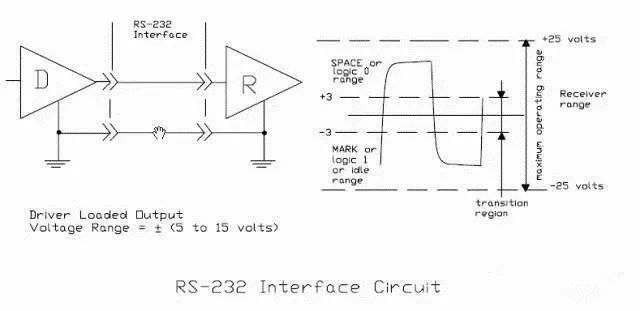
Unbalanced serial communication interfaces RS-423, RS-449
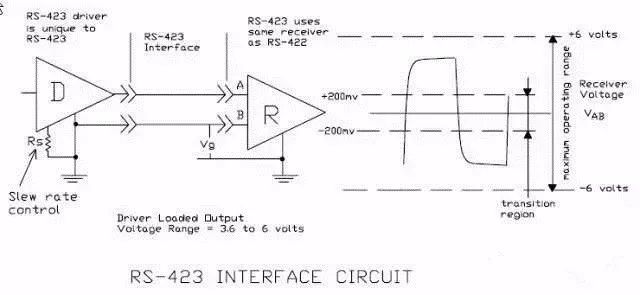
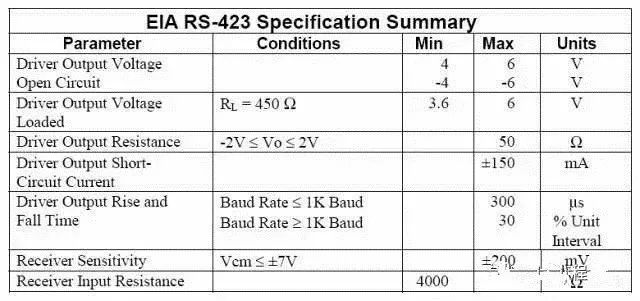
Balanced serial communication interface RS-422
RS-422 (EIA RS-422-A Standard) is the serial connection standard for Apple’s Macintosh computers. RS-422 uses differential signals, while RS-232 uses unbalanced reference ground signals. Differential transmission uses two wires to send and receive signals. Compared to RS-232, it has better noise immunity and longer transmission distances. In industrial environments, better noise resistance and longer transmission distances are significant advantages.
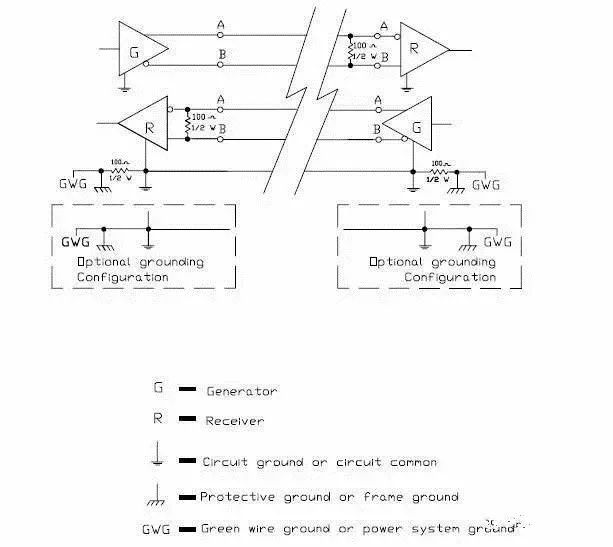
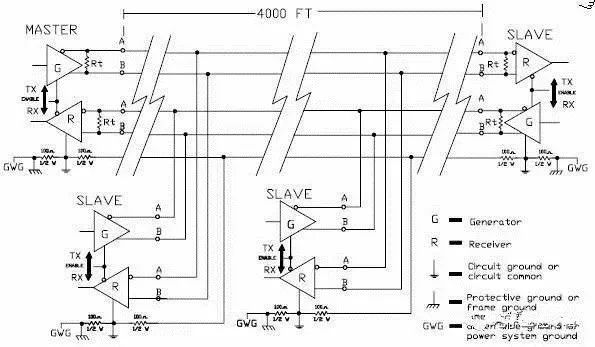
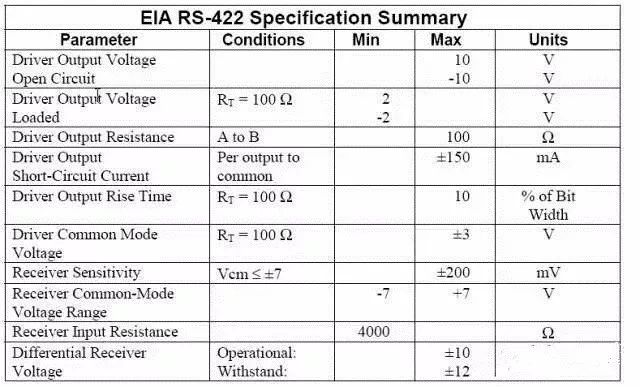
4. Comparison Between RS-232 and RS-485
1. Anti-interference: The RS-485 interface uses a combination of balanced drivers and differential receivers, providing good noise immunity. The RS-232 interface uses one signal line and one return signal line to form a common ground transmission method, which is prone to common-mode interference.
2. Transmission distance: The maximum standard transmission distance for RS-485 is 1200 meters (at 9600bps), which can actually reach 3000 meters. RS-232 has a limited transmission distance, with a maximum standard value of 50 meters, but in reality, it can only be used at around 15 meters.
3. Communication capability: The RS-485 interface allows for the connection of up to 128 transceivers on the bus, enabling users to easily establish a device network using a single RS-485 interface. RS-232 only allows point-to-point communication.
4. Transmission rate: RS-232 has a relatively low transmission rate, with a baud rate of 20Kbps during asynchronous transmission. RS-485 has a maximum data transmission rate of 10Mbps.
5. Signal lines: A half-duplex network formed by the RS-485 interface generally only requires two signal lines. The RS-232 port typically uses three lines: RXD, TXD, and GND.
6. Electrical voltage levels: The logic “1” of RS-485 is represented by the voltage difference between the two wires being + (2-6)V; Logic “0” is represented by the voltage difference being – (2-6)V. In RS-232-C, the voltage on any signal line is negative logic. That is: Logic “1” is -5 to -15V; Logic “0” is +5 to +15V.
5. Comparison Between RS-422 and RS-485
The electrical performance of RS-485 is identical to that of RS-422. The main differences are:
1. RS-422 has 4 signal lines: two for sending (Y, Z) and two for receiving (A, B). Since RS-422 separates receiving and transmitting, it can send and receive simultaneously (full duplex).
2. RS-485 has only two data lines: sending and receiving are both A and B. Since RS-485 shares the same two lines for sending and receiving, it cannot send and receive simultaneously (half duplex).
RS-485 standards use balanced transmission and differential reception data transceivers to drive the bus, with specific specifications:
The input resistance of the receiver RIN ≥ 12kΩ
The driver can output a common mode voltage of ±7V
The input capacitance ≤ 50pF
With 32 nodes configured and a 120Ω termination resistor, the driver must still output a voltage of at least 1.5V (the size of the termination resistor depends on the parameters of the twisted pair used).
The input sensitivity of the receiver is 200mV (i.e., (V+) – (V-) ≥ 0.2V, indicating signal “0”; (V+) – (V-) ≤ -0.2V, indicating signal “1”).
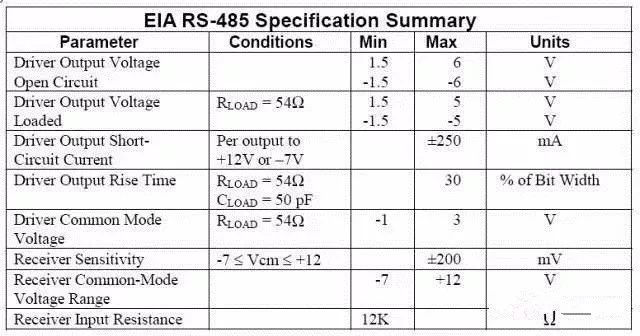
Due to the long distance, multi-node (32 nodes), and low cost of transmission lines, EIA RS-485 has become the preferred standard for data transmission in industrial applications.
(1) The electrical characteristics of RS-485: The sending end: Logic “0” is represented by the voltage difference between the two wires being + (2~6)V; Logic “1” is represented by the voltage difference being – (2~6)V. The receiving end: A is considered logic “0” if it is more than 200mV higher than B, and A is considered logic “1” if it is more than 200mV lower than B;
(2) The maximum data transmission rate for RS-485 is 10Mbps. However, since RS-485 often needs to communicate with the RS-232 port of a PC, the actual maximum is generally 115.2Kbps. Also, because a too high rate will reduce the transmission distance of RS-485, it is often around or below 9600bps;
(3) The RS-485 interface uses a combination of balanced drivers and differential receivers, providing good noise immunity;
(4) The maximum transmission distance for the RS-485 interface is 1200 meters (at 9600bps), which can actually reach 3000 meters. The RS-485 interface allows for the connection of up to 128 transceivers on the bus, meaning RS-485 has multi-machine communication functionality, allowing users to easily establish a network using a single RS-485 interface. Because the RS-485 interface forms a half-duplex network, it generally only requires two signal lines, so RS-485 interfaces use twisted pair transmission. The international standard for RS-485 does not specify a connector standard, so terminal blocks or DB-9, DB-25 connectors can be used.
When using the RS-485 interface, for a specific transmission line diameter, the maximum cable length allowed for data signal transmission from the generator to the load is a function of the data signal rate, which is mainly limited by signal distortion and noise. The maximum cable length and signal rate relationship curve is derived using a 24AWG copper core twisted pair telephone cable (diameter 0.51mm), with a line-to-line bypass capacitance of 52.5PF/M and a terminal load resistance of 100 ohms. (Quoted from GB11014-89 Appendix A). When the data signal rate drops below 90Kbit/S, assuming the maximum allowable signal loss is 6dBV, the cable length is limited to 1200m. In practice, it is entirely possible to achieve greater cable lengths. When using cables of different diameters, the maximum cable lengths will differ. For example, when the data signal rate is 600Kbit/S, using 24AWG cable, the maximum cable length is 200m; if using 19AWG cable (diameter 0.91mm), the cable length can exceed 200m; if using 28AWG cable (diameter 0.32mm), the cable length can only be less than 200m.
For long-distance communication using RS-485, it is recommended to use shielded cables and connect the shield layer as a ground.
6. Three Factors Affecting RS-485 Bus Communication Speed and Reliability
1. Signal reflections in communication cables
During communication, two signal factors lead to signal reflections: impedance discontinuity and impedance mismatch.
Impedance discontinuity occurs when the signal suddenly encounters a cable with very low or no impedance at the end, causing signal reflections at that point, similar to how light reflects when it enters a different medium. To eliminate this reflection, a termination resistor matching the cable’s characteristic impedance must be bridged at the end of the cable to make the cable’s impedance continuous. Since the signal transmission on the cable is bidirectional, a termination resistor of the same size can also be bridged at the other end of the communication cable.
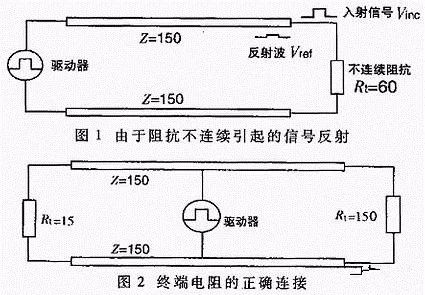
From a theoretical analysis, as long as a termination resistor matching the cable’s characteristic impedance is bridged at the end of the transmission cable, signal reflection should no longer occur. However, in practical applications, due to the characteristic impedance of the transmission cable being related to communication baud rates and other application environments, the characteristic impedance cannot be perfectly equal to the termination resistor, so some degree of signal reflection will still exist.
Another cause of signal reflection is the impedance mismatch between the data transceiver and the transmission cable. This type of reflection mainly manifests when the communication line is in idle mode, leading to data chaos across the entire network.
The impact of signal reflections on data transmission ultimately stems from the fact that reflected signals trigger the comparator at the receiver’s input, causing the receiver to receive incorrect signals, leading to CRC check errors or entire data frame errors.
In signal analysis, the parameter used to measure the strength of the reflected signal is the RAF (Reflection Attenuation Factor). Its calculation formula is as follows:
RAF=20lg(Vref/Vinc) (1)
Where: Vref—voltage magnitude of the reflected signal; Vinc—voltage magnitude of the incident signal at the cable and transceiver or terminal resistor connection point.
The specific measurement method is shown in Figure 3. For example, if it is measured that the peak-to-peak value of the incident signal sine wave at 2.5MHz is +5V and the peak-to-peak value of the reflected signal is +0.297V, then the reflection attenuation factor of this communication cable at a communication rate of 2.5MHz is:
RAF=20lg(0.297/2.5)=-24.52dB
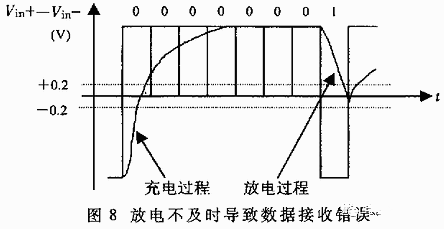
To reduce the impact of reflected signals on communication lines, noise suppression and adding bias resistors are often used. In practical applications, for relatively small reflected signals, the method of adding bias resistors is often used for simplicity and convenience. The principle of how to improve communication reliability through adding bias resistors in communication lines is as follows.
2. Signal attenuation in communication cables
The second factor affecting signal transmission is the attenuation of the signal during transmission through the cable. A transmission cable can be viewed as an equivalent circuit composed of distributed capacitance, distributed inductance, and resistance, as shown.
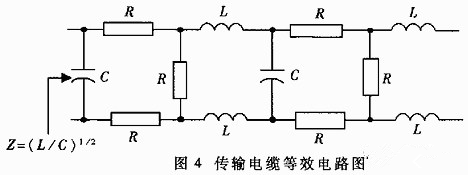
The distributed capacitance C of the cable is mainly generated by the two parallel conductors of the twisted pair. The resistance of the conductors has a negligible effect on the signal and can be ignored. The signal loss is mainly due to the LC low-pass filter formed by the distributed capacitance and distributed inductance. The attenuation coefficient of the LAN standard two-core cable (the standard cable selected by Siemens for the DP bus) at different baud rates is shown in Table 1.
The attenuation coefficient of the cable
3. Pure resistive load in communication cables
The third factor affecting communication performance is the size of the pure resistive load (also called DC load). Here, the pure resistive load mainly consists of the termination resistor, bias resistor, and RS-485 transceiver.

When discussing the EIA RS-485 specification, it was mentioned that the RS-485 driver can output at least 1.5V of differential voltage with 32 nodes and a configuration of 150Ω termination resistors. The input resistance of one receiver is 12kΩ, and the equivalent circuit for the entire network is shown in Figure 5. Based on this calculation, the load capacity of the RS-485 driver is:
RL=32 input resistors in parallel with 2 termination resistors=(((12000/32) × (150/2)) / (12000/32) + (150/2)) ≈ 51.7Ω
Currently, commonly used RS-485 drivers include MAX485, DS3695, MAX1488/1489, and SN75176A/D used by Holley Technology, among which some RS-485 drivers can achieve load capacities of up to 20Ω. Not considering many other factors, based on the relationship between driving capacity and load, the maximum number of nodes that a driver can support will far exceed 32.
In high baud rate communications, bias resistors are necessary. The connection method for bias resistors is shown in Figure 6. Their function is to pull the level of the bus away from 0V when the line enters an idle state (idle mode), as shown in Figure 7. This way, even if small reflected signals or interference occur in the line, the data receivers connected to the bus will not malfunction due to these signals.
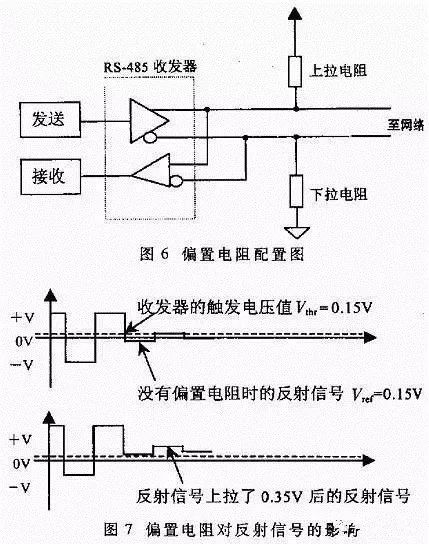
Through the following example, the size of the bias resistor can be calculated:
Termination resistors Rt1=Rr2=120Ω;
Assuming the maximum peak-to-peak value of the reflected signal Vref≤0.3Vp-p, the negative half of the voltage Vref≤0.15V; the reflected current Iref caused by the reflected signal on the termination resistor ≤0.15/(120||120)=2.5mA. The hysteresis voltage value of a typical RS-485 transceiver (including SN75176) is 50mV, that is:
(Ibias-Iref) × (Rt1||Rt2) ≥ 50mV
Thus, it can be calculated that the bias current Ibias ≥ 3.33mA
+5V=Ibias(Rup+Rdown+(Rt1||Rt2)) (2)
Using equation (2), it can be calculated that Rup=Rdown=720Ω
In practical applications, there are two methods for adding bias resistors to the RS-485 bus:
(1) Distributing the bias resistors evenly to each transceiver on the bus. This method adds bias resistors to each transceiver connected to the RS-485 bus, providing each transceiver with a bias voltage.
(2) Using a pair of bias resistors on a segment of the bus. This method is particularly effective for large reflected signals or interference signals on the bus. It is worth noting that adding bias resistors increases the load on the bus.
7. Relationship Between RS-485 Bus Load Capacity and Communication Cable Length
When designing the network configuration composed of RS-485 buses (bus length and number of loads), three parameters should be considered: pure resistive load, signal attenuation, and noise margin. The pure resistive load and signal attenuation have been discussed previously; now we will discuss the noise margin. The noise margin of the RS-485 bus receiver should be greater than 200mV. The previous discussions assumed a noise margin of 0. In practical applications, to enhance the bus’s anti-interference capability, it is always hoped that the system’s noise margin is better than that specified in the EIA RS-485 standard. The relationship between the number of loads on the bus and the communication cable length can be seen from the following formula:
Vend=0.8(Vdriver-Vloss-Vnoise-Vbias)(3)
Where: Vend is the signal voltage at the end of the bus, which is specified as 0.2V during standard measurements; Vdriver is the output voltage of the driver (which depends on the number of loads. For 5 to 35 loads, Vdriver=2.4V; when the load number is less than 5, Vdriver=2.5V; when the load number exceeds 35, Vdriver≤2.3V); Vloss is the loss of the signal during transmission through the bus (which depends on the specifications and length of the communication cable), calculated using the standard cable’s attenuation coefficient provided in Table 1, based on the formula attenuation coefficient b=20lg(Vout/Vin), it can be calculated that Vloss=Vin-Vout=0.6V (Note: The communication baud rate is 9.6kbps, and the cable length is 1km. If the baud rate increases, Vloss will also increase); Vnoise is the noise margin, which is specified as 0.1V during standard measurements; Vbias is the bias voltage provided by the bias resistors (typical value is 0.4V).
In equation (3), multiplying by 0.8 ensures that the communication cable does not enter a fully loaded state. From equation (3), it can be seen that the size of Vdriver is inversely proportional to the number of loads on the bus, and the size of Vloss is inversely proportional to the length of the bus; the other parameters depend only on the type of driver used. Therefore, for a selected RS-485 driver, with a fixed communication baud rate, the number of loads on the bus is directly related to the maximum distance that the signal can be transmitted. The specific relationship is: within the allowable range of the bus, the more loads there are, the shorter the signal transmission distance; the fewer loads, the longer the signal transmission distance.
8. The Impact of Distributed Capacitance on RS-485 Bus Transmission Performance
The distributed capacitance of the cable is mainly generated by the two parallel conductors of the twisted pair. Additionally, there is also distributed capacitance between the conductors and ground, which is very small but cannot be ignored in analysis. The impact of distributed capacitance on bus transmission performance mainly arises because the transmitted signal on the bus is a fundamental wave signal, and the signal can only be expressed as “1” and “0”. In special bytes, such as 0x01, the signal “0” allows sufficient charging time for the distributed capacitance, while when the signal “1” arrives, due to the charge in the distributed capacitance, it cannot discharge in time, resulting in (Vin+) – (Vin-) still being greater than 200mV, leading the receiver to mistakenly identify it as “0,” ultimately causing CRC check errors and errors in the entire data frame transmission. The specific process is illustrated in the diagram.
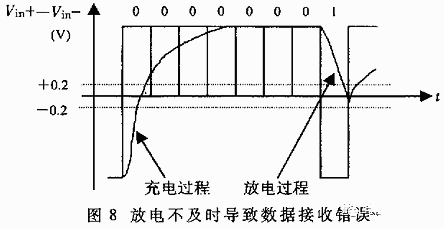
The impact of distributed effects on the bus can lead to data transmission errors, thereby reducing the overall network performance. Two methods can solve this issue:
(1) Reduce the data transmission baud rate;
(2) Use cables with smaller distributed capacitance to improve the quality of the transmission line.
Simply connecting the A and B ends of each interface using a pair of twisted wires without grounding the RS-485 communication link can work under certain conditions, but it poses a risk to the system. The RS-485 interface transmits signals differentially and does not require a reference point to detect the signal system; it only needs to detect the potential difference between the two wires. However, it should be noted that the transceiver can only operate normally when the common-mode voltage does not exceed a certain range (-7V to +12V). When the common-mode voltage exceeds this range, it can affect communication reliability and even damage the interface. As shown in Figure 1, when transmitter A sends data to receiver B, the common-mode voltage VOS of transmitter A’s output, due to the existence of ground potential difference VGPD between two systems with their own independent grounding systems, will cause the common-mode voltage at the receiver’s input to reach VCM=VOS+VGPD. The RS-485 standard stipulates that VOS≤3V, but VGPD can vary significantly (dozens of volts or even higher), and may be accompanied by strong interference signals, causing the receiver’s common-mode input VCM to exceed the normal range, leading to interference currents on the signal line, affecting normal communication or damaging equipment.
Conclusion:
The serial port is a very versatile device interface, commonly used in instruments and equipment for communication, often used for remote data collection or remote control. The development of serial ports is relatively simple, making it one of the favorite interfaces for many engineers.
Important Notice
Want to join the Electrical Automation Technology Exchange Group
Please add the leader as a friend
And note: Region-Industry-Name/Nickname to obtain group entry qualifications.

Electrical Automation
Professional and focused sharing
Share to Moments, share with friends
——————————————————————
▣ Source: Industrial Control Classroom-www.gkket.com, infringement deletion!
▣ Statement: We respect originality. Text, images, and video materials are copyrighted to the original author. Some articles were not able to contact the original author for various reasons when pushed. If there are copyright issues, please contact the original author for deletion (contact 17621634088 - WeChat same number), we only share for non-commercial purposes.

They all follow, what are you waiting for?








